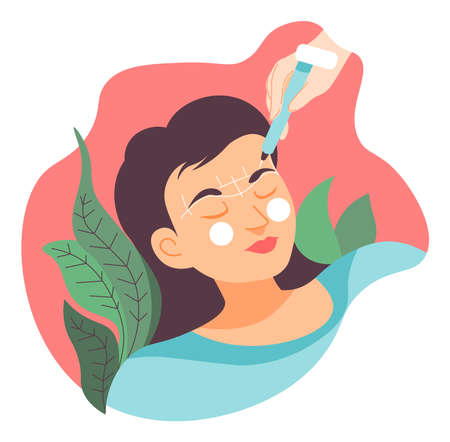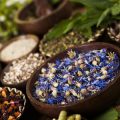Introduction to Tulsi and Its Importance in Indian Households
In the heart of every Indian home, one can often find a lush green Tulsi plant, revered not only for its spiritual significance but also for its time-honoured role in daily wellness rituals. Known as Holy Basil in English, Tulsi holds a sacred place in Indian culture, where it is lovingly tended to and worshipped as the “Queen of Herbs.” For generations, Tulsi has been an integral part of Indian households, believed to protect families from negative energies and promote overall health. Its leaves are commonly used in prayers and traditional remedies, especially when it comes to skin care. Passed down through centuries, Indian grandmothers have trusted Tulsi for its powerful ability to soothe and heal common skin problems such as acne, rashes, and dullness. This sacred herb is more than just a symbol of devotion; it is celebrated for its natural antibacterial, antifungal, and anti-inflammatory properties that make it a cherished ingredient in effective home remedies for healthy Indian skin.
Understanding Common Indian Skin Concerns
Indias diverse climate, ranging from humid coastal regions to dry northern plains, combined with high levels of pollution and unique lifestyle habits, presents a set of skin challenges for many Indians. These factors significantly impact the health and appearance of the skin, making it crucial to address them with natural remedies like Tulsi (Holy Basil).
Typical Skin Issues Among Indians
| Skin Concern | Main Causes | Common Symptoms |
|---|---|---|
| Acne & Pimples | Humidity, oily skin types, air pollution, hormonal changes | Red bumps, pustules, clogged pores, inflammation |
| Pigmentation & Dark Spots | Sun exposure, hormonal imbalance, urban pollution | Uneven skin tone, dark patches, dullness |
| Rashes & Allergies | Sweat retention, harsh chemicals in products, environmental allergens | Itching, redness, small bumps or blisters |
| Dryness & Flakiness | Cold weather in North India, hard water, frequent washing with soap | Tightness, rough texture, visible flakes |
| Sensitivity & Irritation | Frequent use of cosmetics, changing weather conditions | Burning sensation, redness, easy irritation |
The Role of Lifestyle and Environment
The fast-paced urban lifestyle in Indian cities often leads to increased stress and irregular eating habits. Combined with exposure to vehicular and industrial pollutants and long hours under the sun or in air-conditioned environments, these factors aggravate common skin issues. Traditional home remedies passed down through generations offer gentle yet effective solutions that suit Indian skin types.
Tulsi: A Trusted Ingredient for Indian Skin Health
Tulsi is revered not only for its spiritual significance but also for its potent healing properties. Its anti-inflammatory and antibacterial benefits make it a popular choice for addressing the very skin concerns prevalent across India’s varied climates. In the following sections, we will explore how Tulsi can be integrated into home remedies tailored specifically for typical Indian skin problems.
![]()
3. Why Tulsi is a Trusted Remedy for Skin Problems
Tulsi, also known as Holy Basil, holds a special place in every Indian home, often revered as a sacred plant with countless health benefits. But beyond its spiritual importance, Tulsi is widely trusted for treating skin issues due to its powerful natural properties that have been celebrated in Ayurveda for centuries. In the world of Ayurvedic remedies, Tulsi is renowned for its antibacterial, antifungal, and anti-inflammatory qualities, making it an effective “ghar ka nuskha” (home remedy) for many common skin problems.
Antibacterial Power: Fighting Off Germs Naturally
Tulsi leaves are packed with essential oils like eugenol and camphene, which act as strong antibacterial agents. This means Tulsi can help prevent and control pimples, acne, and minor infections by destroying harmful bacteria on the skin’s surface. That’s why our grandmothers often suggested applying a paste of crushed Tulsi leaves on breakouts—a time-tested Indian solution that keeps the skin clean without harsh chemicals.
Antifungal Benefits: Keeping Skin Clear and Healthy
Fungal infections like ringworm or “daad” are common during the humid Indian monsoon. Tulsi comes to the rescue here too! Its antifungal properties help inhibit the growth of fungi that cause itching, redness, and irritation. Using Tulsi-infused water or homemade face packs can soothe these troubles naturally, just like the age-old practice of adding Tulsi leaves to bath water for healthy skin.
Anti-inflammatory Action: Soothing Irritated Skin
Ayurveda describes Tulsi as “Shothahara”—an herb that reduces swelling and inflammation. When you apply Tulsi juice or paste to rashes, insect bites, or even sunburn (a common worry in hot Indian summers), it calms redness and discomfort quickly. This gentle healing makes Tulsi a safe choice even for sensitive skin types and children.
Rooted in Tradition, Backed by Science
The wisdom of using Tulsi isn’t just folklore—modern studies confirm what Indian families have practiced for generations. Whether it’s in a simple “ubtan” (herbal scrub) or mixed with honey and turmeric for a soothing mask, Tulsi’s effectiveness stands strong. So next time your skin acts up, remember this humble plant growing in your courtyard is more than just a symbol of purity—it’s your own herbal pharmacy for radiant, healthy skin.
4. Simple Home Remedies with Tulsi for Glowing Skin
If you wish to harness the age-old wisdom of Ayurveda, Tulsi (Holy Basil) is a must-have ingredient in your daily skin care. It’s not only sacred in Indian households but also packed with antibacterial and anti-inflammatory properties that can address common skin problems like acne, dullness, and blemishes. Here are some simple DIY Tulsi-based remedies using ingredients easily found in Indian kitchens:
Tulsi Face Pack for Clear Skin
Ingredients: Fresh Tulsi leaves, Multani Mitti (Fuller’s Earth), Rose Water
Method: Crush a handful of Tulsi leaves into a paste. Mix with 1 tablespoon Multani Mitti and enough rose water to make a smooth paste. Apply on the face, leave for 15 minutes, then rinse with cool water.
Tulsi-Neem Paste for Acne-Prone Skin
Ingredients: Tulsi leaves, Neem leaves, Turmeric powder
Method: Grind equal parts of Tulsi and Neem leaves. Add a pinch of turmeric powder and a little water to form a paste. Apply on affected areas or as a full-face mask. Leave for 10-12 minutes and wash off gently.
Tulsi-Infused Toner for Daily Refreshment
Ingredients: Fresh Tulsi leaves, Cucumber juice, Lemon juice
Method: Boil 10-15 Tulsi leaves in half a cup of water. Let it cool, strain, and mix with 2 tablespoons cucumber juice and 1 teaspoon lemon juice. Use this toner after cleansing your face for refreshing hydration.
Quick Comparison of DIY Tulsi Remedies
| Remedy | Main Ingredients | Skin Benefit | Frequency |
|---|---|---|---|
| Tulsi Face Pack | Tulsi, Multani Mitti, Rose Water | Cleanses & Brightens | Once or Twice Weekly |
| Tulsi-Neem Paste | Tulsi, Neem, Turmeric | Fights Acne & Blemishes | Twice Weekly |
| Tulsi Toner | Tulsi, Cucumber Juice, Lemon Juice | Cools & Tones Skin | Daily Use |
A Gentle Reminder for Indian Skin Types:
Tulsi remedies are gentle yet effective for most Indian skin types. Always do a patch test before trying any new remedy, especially if you have sensitive skin. With regular use, these home-based treatments can help revive your natural glow while keeping your skin healthy and radiant the desi way!
5. Tips for Using and Preserving Tulsi at Home
Growing Tulsi in Your Indian Home
Tulsi, known as Holy Basil, holds a sacred space in many Indian households—not just for its spiritual significance, but also for its exceptional skin care benefits. Growing Tulsi at home is both simple and rewarding. Place your Tulsi plant in a sunny spot, ideally facing east or north for auspicious energy, and use well-draining soil. Water the plant regularly, but avoid overwatering, especially during monsoon season. Prune the leaves gently to encourage bushy growth. In Indian culture, offering water to Tulsi every morning is believed to bring positivity and good health.
Harvesting and Storing Fresh Tulsi Leaves
To maximize the potency of Tulsi for your daily skin care rituals, harvest the leaves early in the morning when their essential oils are most concentrated. Gently pluck mature leaves without damaging the stem. For immediate use, wash the leaves with filtered water to remove dust and impurities common in Indian urban areas.
Best Practices for Storage
If you have an abundant supply of fresh Tulsi, store washed and dried leaves in a clean cotton cloth or paper bag inside the refrigerator; this helps retain their freshness for up to one week. Alternatively, air-dry excess leaves in a shaded area—never under direct sunlight—to preserve their nutrients and aroma. Once fully dried, store them in an airtight glass jar away from moisture and heat.
Incorporating Tulsi into Daily Skin Care Rituals
For healthy Indian skin, use fresh Tulsi leaves to prepare face packs, toners, or simple cleansing pastes. Crush a few fresh leaves with rose water or curd to create a soothing mask suitable for humid climates. You can also make a gentle Tulsi-infused water by soaking leaves overnight and using it as a natural toner every morning.
Cultural Tip:
Many Indian families perform “Tulsi puja” before harvesting leaves; this mindful approach not only honours tradition but brings calmness and positive energy into your self-care routine.
6. Precautions and When to Consult a Doctor
Tulsi, or Holy Basil, has been cherished in Indian households for generations as a natural remedy for common skin issues. While its healing and purifying qualities offer significant relief for minor problems like acne, rashes, or dullness, it is important to remember that not all skin conditions can be managed at home. Sometimes, traditional home remedies may not be enough, and knowing when to seek professional help is vital for your skin’s long-term health.
Recognizing Limitations of Home Remedies
Home remedies using Tulsi are generally safe and effective for mild skin irritations, but there are certain situations where self-treatment could delay proper care or even worsen the condition. If you notice that your symptoms persist despite regular application of Tulsi-based packs or oils, or if the irritation spreads, it may indicate an underlying issue that requires medical intervention.
Signs You Need to See a Dermatologist
- Persistent Redness or Swelling: If redness, itching, or swelling does not subside within a week, consult a doctor.
- Severe Acne or Painful Breakouts: Deep cystic acne or painful nodules often require prescription treatment.
- Open Sores or Infections: Any wound that becomes pus-filled or starts spreading needs immediate attention.
- Discolouration or Sudden Changes: Rapid changes in pigmentation or texture should always be evaluated by a dermatologist.
- Allergic Reactions: If you experience burning, hives, difficulty breathing, or severe itching after applying Tulsi remedies, seek help immediately.
The Importance of Professional Guidance
Especially for those with sensitive Indian skin types prone to pigmentation and scarring, consulting a qualified dermatologist ensures that you receive the correct diagnosis and treatment plan. Doctors can also guide you on how to safely incorporate traditional ingredients like Tulsi into your skincare routine without causing adverse effects. Remember, healthy skin is not only about external care but also about addressing internal health and lifestyle factors—something a healthcare professional can best advise you on.
If in doubt, always prioritise safety over tradition. Trust your instincts and never hesitate to reach out to a medical expert for persistent or severe skin concerns. Your skin deserves the best care possible.

